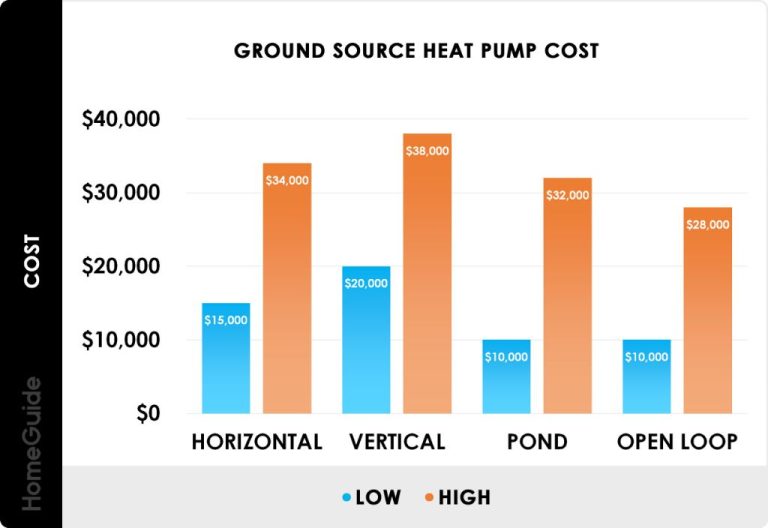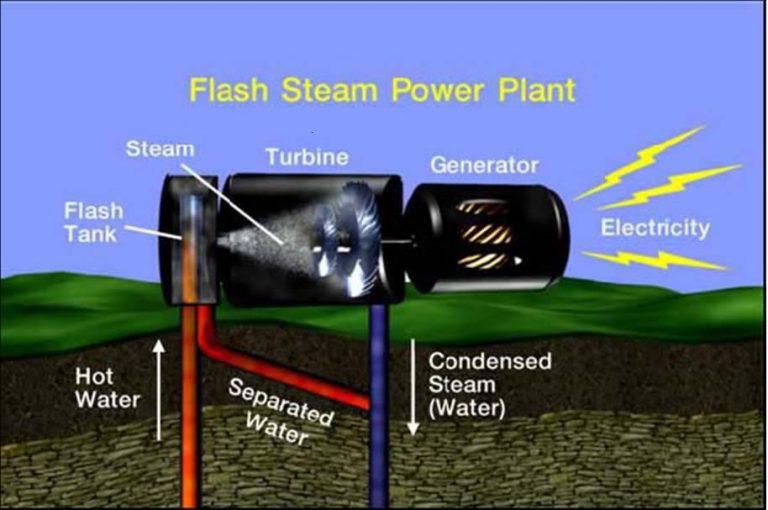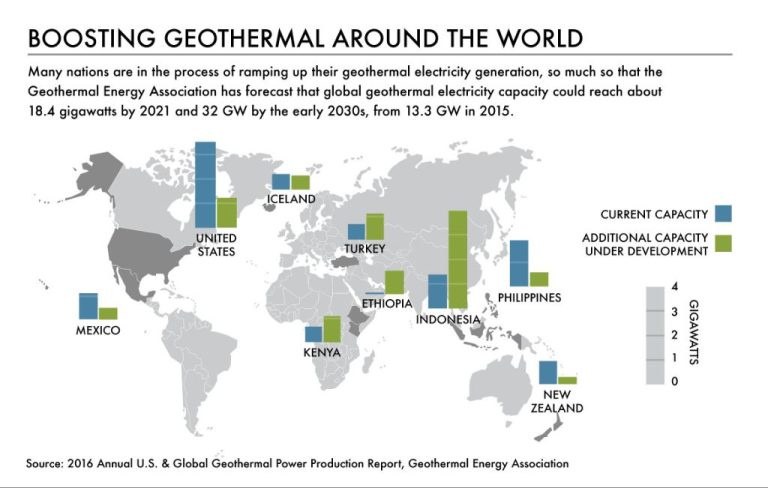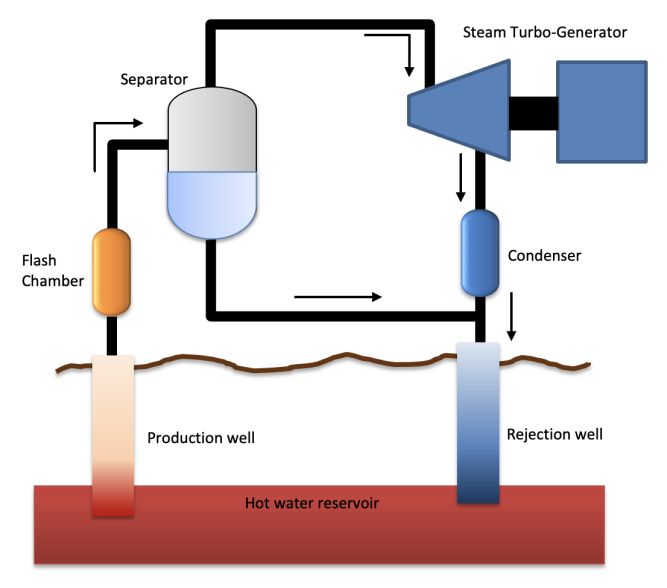Geothermal Electricity Generation At Utility Scale
I’ve always been fascinated by our planet’s natural energy flows and cycles. The steady heat radiating from Earth’s core keeps our world habitable at the surface, yet that bountiful energy source remains mostly untapped on a large scale. Geothermal energy has the potential to provide vast amounts of clean, renewable electricity for utilities and communities worldwide. However, bringing geothermal power generation from an inspiring concept to widespread reality faces significant technological and economic hurdles. In this post, I will explore the current state of geothermal electricity generation at utility scales. I will outline the types of geothermal resources and technologies used today, examine some high-profile geothermal projects around the world, and discuss both the opportunities and challenges involved in transitioning more energy systems to this renewable heat from within the Earth.
What Is Geothermal Energy And How Does It Work?
Geothermal energy is a type of renewable energy that is derived from the heat stored within the Earth’s crust. This heat arises from various natural processes, including the decay of radioactive materials within the Earth’s core and the residual heat trapped within rocks since the planet’s formation. Geothermal energy is considered one of the most reliable and consistent forms of renewable energy, since the Earth’s core temperature remains relatively consistent over time.
Geothermal energy works by tapping into natural hot springs and geysers, which can reach temperatures of up to 370 oC. This hot water and steam can be used to generate electricity through a variety of technologies. One popular method of geothermal energy generation is called the binary cycle power plant. In this process, hot geothermal water heats a secondary fluid with a lower boiling point, such as isobutane or ammonia. The secondary fluid then evaporates and drives a turbine, which generates electricity.
Another form of geothermal energy generation is called the flash steam power plant. In this method, high-pressure geothermal water is brought to the surface and rapidly depressurized, causing it to flash into steam. This steam is then used to drive a turbine and generate electricity. A variation of this technology, called the dry steam power plant, involves using natural steam from geothermal sources to power turbines directly.
Geothermal energy can also be used for a variety of other purposes beyond electricity generation. It can be used for heating and cooling buildings, greenhouse agriculture, aquaculture, and even for enhancing oil and gas recovery. In addition, geothermal energy has been proposed as a way to power hydrogen fuel cells, providing a clean and renewable source of energy for transportation.
Despite its many benefits, geothermal energy still faces several challenges that limit its widespread adoption. The biggest challenge is the high upfront costs of geothermal power plant construction, which can be several times more expensive than traditional fossil fuel power plants. Additionally, geothermal resources are often located in remote areas that require significant infrastructure investment to access. Finally, geothermal energy generation can sometimes cause seismic activity and other environmental impacts, making it important to carefully site geothermal projects to minimize these effects.
Despite these challenges, geothermal energy holds tremendous promise for providing reliable and sustainable energy for communities around the world. With ongoing technological advancements and increased public support for renewable energy, it is likely that geothermal energy will play an increasingly important role in our future energy mix.
Benefits Of Using Geothermal For Electricity Generation
The use of geothermal energy for electricity generation offers numerous benefits that make it a compelling option for utilities and communities to pursue. One advantage is that geothermal energy is a clean, renewable source of energy that produces little to no greenhouse gas emissions. This is crucial in the fight against climate change, as it allows for the reduction of carbon emissions from traditional fossil fuel power plants. Moreover, geothermal energy is not subject to the same market fluctuations as traditional fossil fuels, which makes it a stable and reliable source of energy for decades to come.
Another significant benefit of geothermal energy is its scalability. Geothermal energy can be generated at utility scale, but also at smaller scales, making it well-suited for community-level projects. This makes it an ideal choice for rural and remote areas that may not have access to traditional power grids. Moreover, geothermal energy is not limited by climate or weather conditions, which means that it can be generated 24/7, providing a consistent source of energy to meet community needs.
In addition, geothermal energy is cost-effective over the long term. While the initial construction costs for a geothermal power plant may be high, the long-term operational costs are significantly lower than those of traditional fossil fuel power plants. The life cycle of a geothermal power plant can be up to 50 years, meaning that the investment in the construction of a geothermal plant is paid back over many years by the lower fuel and maintenance costs.
Furthermore, geothermal energy has the potential to create jobs and boost local economies. The construction and operation of a geothermal power plant requires a range of skilled professionals including engineers, geologists, and technicians. Moreover, the development of geothermal resources can stimulate local economies through the creation of infrastructure and increased economic activity.
Current State Of Geothermal Energy Production At Utility Scale
The current state of geothermal energy production at utility scale presents notable opportunities and challenges. While geothermal power plants have been successfully developed and operated across the world, there are still technological and economic hurdles to overcome for geothermal energy to provide a significant portion of the world’s electricity.
Geothermal resources are classified into three broad categories: high temperature, moderate temperature, and low temperature resources. High temperature resources, which are found mainly in volcanic regions, typically range from 150 to over 300 °C and are used to generate electricity using binary-cycle or flash steam power plants. Moderate temperature resources, which are found in sedimentary basins or areas of enhanced geothermal systems, are typically between 50 to 150 °C and are used to generate electricity using binary-cycle power plants. Lastly, low temperature resources, which are the most widespread and are found almost everywhere on Earth, are typically below 80 °C and are used for direct-use applications such as heating and cooling.
Currently, the largest geothermal power plants in the world are located in the United States, Indonesia, and the Philippines. The Geysers, a complex of 22 geothermal power plants in California, USA, is the largest individual geothermal facility in the world, with an installed capacity of over 1,500 MW. In Indonesia, the Wayang Windu geothermal power plant has an installed capacity of 227 MW, while the Darajat geothermal power plant has an installed capacity of 255 MW. The Philippines is the second-largest geothermal electricity producer in the world, with over 1,900 MW installed capacity.
Despite these achievements, geothermal energy still accounts for only a fraction of the world’s electricity generation. According to the International Energy Agency, the total installed capacity of geothermal power plants worldwide was 14.9 GW in 2019, providing only 0.3% of global electricity supply. This underutilization of geothermal energy can be attributed to several factors, including the high upfront capital costs of developing geothermal power projects, the limited availability of high-temperature resources, and the significant technological challenges involved in developing low-temperature resources.
To overcome these challenges, significant investments are required to improve existing geothermal technologies, develop new ones, and increase the exploration and assessment of geothermal resources. Governments and private entities must work together to create the necessary infrastructure to facilitate the adoption of geothermal energy, including establishing regulatory frameworks, incentivizing research and development, and providing financing and technical support. By doing so, we can unlock the full potential of geothermal energy to provide reliable, clean, and affordable electricity for communities worldwide.
Potential For Growth And Expansion In The Future
Looking to the future, there is enormous potential for growth and expansion in the geothermal energy sector. The International Renewable Energy Agency (IRENA) estimates that by 2050, the installed capacity of geothermal power plants could reach 14% of global electricity demand, providing up to 2,000 GW of clean, renewable energy. This significant increase in energy production could greatly reduce greenhouse gas emissions and contribute to efforts to combat climate change.
One area of potential expansion is the development of enhanced geothermal systems (EGS). These systems use more advanced drilling and reservoir stimulation techniques to access geothermal energy in areas where high-temperature resources are not naturally available. EGS can potentially increase the number of available geothermal resources and expand the geographical range of geothermal energy production.
Another area of potential growth is the integration of geothermal energy with other renewable energy sources, such as solar and wind power. This could be achieved through innovative energy storage technologies and smart grid systems, allowing utilities to manage the variability of renewable energy sources and provide a more consistent and reliable supply of electricity.
In addition, the increased use of direct-use applications for low-temperature geothermal resources, such as district heating, could provide a more efficient and cost-effective method for heating and cooling buildings and communities.
To fully realize the potential for growth and expansion in the geothermal energy sector, continued investment and research are needed to further improve technologies and accelerate the exploration and development of geothermal resources. This includes increased government support and incentives, private investment, and collaboration between industry, academia, and policymakers.
Challenges And Obstacles Facing Geothermal Energy Development
While the potential for geothermal energy is vast and promising, there are several significant challenges and obstacles facing its development. One of the most significant challenges is the high upfront costs associated with geothermal power plants. The construction and drilling of wells required for geothermal power plants is expensive and requires a significant amount of capital investment. The cost of drilling can vary greatly depending on the depth, temperature, and location of the geothermal resource, making it difficult to determine exact upfront costs.
Additionally, the exploration process for geothermal resources can be challenging and time-consuming, which may deter investors and developers from pursuing geothermal energy projects. Exploration techniques used to identify viable geothermal resources can include geophysical surveys, geochemical sampling, and temperature gradient drilling. These methods can take several months or even years to complete and can result in unsuccessful attempts to identify a profitable resource.
Geothermal energy also faces several technical challenges that must be addressed to improve efficiency and reliability. For example, many geothermal power plants experience issues with scaling, corrosion, and mineral buildup in the wells, which can reduce the efficiency and lifespan of the power plant’s equipment. These challenges require ongoing maintenance and monitoring, which can be costly for operators and may reduce the overall profitability of the plant.
Another challenge facing geothermal energy development is the limited availability of suitable sites for power plant development. High-temperature geothermal resources, which are required for utility-scale power production, are rare and often located in remote or inaccessible areas. This can add to the cost and complexity of building and operating geothermal power plants.
Finally, geothermal energy development also faces regulatory challenges, such as obtaining permits and complying with environmental regulations. While geothermal energy is a renewable energy source, the drilling and operation of geothermal power plants can have a negative impact on the environment if not properly managed. This can result in delays and increased costs associated with regulatory compliance.
Case Studies Of Successful Geothermal Power Plants Around The World
Despite the challenges facing geothermal energy, there have been notable success stories of utility-scale geothermal power plants that have overcome these obstacles and have been successfully operating for decades. Here are three case studies of successful geothermal power plants around the world:
1. The Geysers, California, USA
The Geysers is the largest geothermal power complex in the world, located in Northern California. It has been in operation since the early 1960s and currently consists of 18 power plants with a total capacity of 1,517 MW. The power plants tap into a network of underground steam reservoirs located beneath the national park to generate electricity. The Geysers provides roughly 60% of the electricity consumed in the surrounding area. The plants have become increasingly efficient over time and currently have an overall capacity factor of around 70%.
2. Cerro Prieto, Mexico
Cerro Prieto is a geothermal power plant located in Baja California, Mexico. The plant began operating in 1973 and has a current capacity of 720 MW, making it the second-largest producer of geothermal energy in the world. The plant taps into a deep geothermal reservoir located beneath the Cerro Prieto volcano to generate electricity. The plant’s power output is distributed across the Mexican power grid to meet the energy needs of the surrounding area. Cerro Prieto’s success can be attributed to its use of innovative technologies, such as binary systems that have helped increase the efficiency of the plant.
3. Hellisheidi, Iceland
Hellisheidi is the third-largest geothermal power plant in the world, located in southwest Iceland. The plant began operations in 2006 and has a current capacity of 303 MW. It uses a combination of direct steam and binary systems to generate electricity from the hot fluids found deep below the surface. The plant has become a showcase for sustainable energy technology, as it not only produces electricity but also supplies heat to the local community for heating and hot water needs. Hellisheidi has achieved a high capacity factor of around 90%, making it an efficient and reliable source of renewable energy.
How Geothermal Energy Can Contribute To A More Sustainable Future
Geothermal energy has the potential to play a crucial role in transitioning our energy systems toward a more sustainable future. Unlike traditional energy sources such as coal, oil, and natural gas, geothermal energy produces zero to low emissions and is not reliant on external fuel sources. As such, it is a consistent and reliable renewable energy source that can provide steady and uninterrupted energy to homes and businesses alike.
One significant advantage of geothermal energy is its ability to provide a stable and predictable source of electricity. Unlike wind and solar, which are reliant on weather conditions, geothermal energy is available 24/7 and can operate consistently, providing baseload power. Moreover, it is an excellent complement to other renewable energy sources, such as wind and solar, which can be intermittent. By combining these renewable sources, utilities can ensure a reliable and consistent supply of energy while minimizing emissions.
Another advantage of geothermal energy is that it can be harnessed from a wide range of sources, including hot springs, geysers, and even low-temperature resources. This diversity of resources means that geothermal energy can be used in a variety of locations, including those that may not be suitable for wind or solar power. Moreover, geothermal energy can be used for other applications beyond electricity generation, such as heating and cooling, industrial processes, and agricultural uses.
The development of utility-scale geothermal power plants can also provide significant economic benefits to communities. These projects create high-paying jobs during construction and operation, stimulate local economies, and provide a stable source of revenue for host communities. Additionally, geothermal power plants require relatively small land areas, minimizing their impact on surrounding ecosystems.
Despite its many advantages, geothermal energy still faces challenges in becoming a more widespread reality. One significant challenge is the upfront capital costs of building geothermal power plants, which can be high due to the need for specialized equipment and drilling deep into the Earth’s surface. Additionally, the locations of potential geothermal resources may not always coincide with population centers, requiring construction of lengthy transmission lines to distribute power.
Overall, the potential benefits of geothermal energy in contributing to a more sustainable future are substantial. As technological advancements continue and economic barriers are addressed, we may see more widespread adoption of this clean and reliable source of renewable energy.
Comparison With Other Renewable Energy Sources, Such As Solar And Wind
When it comes to renewable energy sources, solar and wind are often the first options that come to mind. While these are undoubtedly important sources of clean energy, they do have limitations. One significant challenge with solar and wind energy is their intermittency. As they rely on weather conditions, they cannot provide energy consistently, leading to energy supply fluctuations. This variability means that storage solutions, such as batteries, are necessary, adding complexity and cost to the energy system.
Geothermal energy, on the other hand, provides reliable and predictable energy that can operate consistently, providing baseload power. Unlike solar and wind, geothermal energy is available 24/7 and does not depend on weather conditions, providing a stable source of energy without needing storage. Furthermore, geothermal energy can also complement other renewable sources, smoothing out the intermittency of wind and solar.
Another advantage of geothermal energy is its long lifespan. Geothermal power plants can operate for 20-30 years, compared to solar panels and wind turbines which typically have a lifespan of 25 years. Geothermal plants also require less maintenance, making them a more reliable and cost-effective option for generating renewable energy.
While solar and wind may be more visible and widely adopted, geothermal energy offers distinct advantages and is becoming an increasingly important source of renewable energy. In fact, geothermal energy resources have the potential to provide four times the world’s current energy consumption, making it a promising option for a sustainable future.
Government Policies And Incentives Supporting Geothermal Development
To encourage the growth of geothermal energy development, many governments worldwide have introduced policies and incentives to support the industry. One such example is the United States’ federal Renewable Portfolio Standard (RPS) program, which requires electricity suppliers to increase the share of renewable electricity generation in their portfolio. Additionally, several states within the US offer tax incentives and grants for geothermal energy projects.
In Europe, the European Union has set a target of achieving 32% renewable energy by 2030 and encourages member states to prioritize geothermal development. In Italy, geothermal energy receives a feed-in tariff that promotes the development of new projects and guarantees a fixed price for energy produced. The German government provides grants and low-interest loans for geothermal projects, while France provides a 20-year feed-in tariff for electricity generated from geothermal sources.
In Asia, Indonesia has one of the largest geothermal energy potentials in the world, and the government has introduced policies to encourage development, such as allowing geothermal projects to receive priority on land-use permits and providing a 7-year tax holiday for investor companies. Japan also has a feed-in tariff system that provides a guaranteed price for electricity produced by geothermal sources.
Overall, government policies and incentives have played a significant role in promoting the development of geothermal energy. By creating a favorable regulatory and financial environment, governments can mitigate the financial risks and technical challenges of developing and deploying geothermal energy systems. These measures can ultimately help to accelerate the transition to clean and sustainable energy sources, while also creating new opportunities for jobs and economic growth in the geothermal energy sector.
Impact Of Geothermal On Local Communities And Economies
Geothermal energy presents vast opportunities for local communities and economies globally. In addition to being a clean and renewable source of electricity, geothermal power generation creates jobs, fuels economic growth, and produces positive impacts on the local environment. Geothermal energy can be generated from various sources such as hydrothermal systems, hot dry rock formations, and geopressured systems, among others.
Locally, communities benefit from geothermal energy projects in many ways. Geothermal power plants often bring significant investment to local economies, creating jobs and improving the standard of living for nearby residents. Besides, the energy generated can be utilized to power local industries, allowing them to reduce their carbon footprint and improve their energy efficiency. The utilization of geothermal energy also reduces the dependence on fossil fuels and the associated environmental impacts, such as greenhouse gas emissions, air pollution, and oil spills.
Moreover, geothermal energy projects often incorporate innovative and sustainable approaches in their construction and operation. For example, the Iceland-based geothermal power company, Reykjavik Geothermal, adopted “sustainable drilling” techniques that minimize the environmental impact of drilling for geothermal energy. These techniques involve using non-toxic, biodegradable drilling fluids and carefully managing and recycling the water used in the drilling process.
In addition to the local benefits of geothermal energy projects, the industry creates excellent opportunities for economic growth regionally and globally. According to the International Renewable Energy Agency (IREA), the global geothermal installed capacity reached 15.4 GW in 2019, with a potential of 100 GW in identified resources. These resources are distributed globally, with significant potential in countries such as the United States, Indonesia, Japan, Kenya, and Ethiopia. It is worth noting that the vast majority of geothermal resources remain untapped, providing ample opportunities for future investment and economic growth.
Moreover, the geothermal energy industry fuels technological advancements in the field, including geothermal drilling, enhanced geothermal system technologies, and direct-use applications such as district heating and cooling. These advancements create not only more effective and efficient use of geothermal resources but also potential business opportunities for manufacturers, suppliers, and geothermal service providers. The implementation of these technologies further strengthens the role of geothermal energy in the transition to a green and sustainable energy future globally.
Future Advancements And Innovations In Geothermal Technology
Future advancements and innovations in geothermal technology hold immense promise for the global energy landscape. As the push towards decarbonization gains momentum, geothermal energy has emerged as a critical player in the transition to a clean, renewable energy mix. The industry has been actively investing in research and development, exploring advanced technologies that can make geothermal power generation more efficient, cost-effective, and scalable.
One area of focus is enhanced geothermal systems (EGS), which involve using technology to increase the permeability of deep underground rocks, allowing for more efficient extraction of heat. In recent years, EGS has shown great potential in unlocking new geothermal resources in a broader range of settings. According to the U.S. Department of Energy, the estimated geothermal resource for EGS is over 500,000 times the country’s annual electricity consumption. Research has shown that EGS has the potential to increase geothermal capacity by a factor of ten globally.
Another promising technology is binary power plants, which are designed to maximize electricity production from low-temperature geothermal resources. Traditional geothermal power plants require water temperatures above 200°C to generate electricity, limiting their applicability. In contrast, binary power plants use a heat exchanger to transfer heat from the geothermal water to a low-boiling-point liquid, such as isobutane. The vapor produced from the heat exchange drives a turbine, generating electricity. This technology has shown great success in Indonesia and the Philippines, indicating that it could be a viable solution for geothermal resources in other parts of the world.
Moreover, geothermal district heating and cooling systems are becoming increasingly popular in urban areas, providing a reliable and sustainable energy source for heating and cooling. The technology involves using the constant temperature of the Earth’s subsurface to heat and cool buildings, reducing energy consumption and greenhouse gas emissions. Many cities worldwide, such as Reykjavik, Paris, and Munich, have already implemented geothermal district heating and cooling systems, with others following suit.
In addition to these technical advancements, innovative financing models are also emerging in the geothermal industry. For instance, crowdfunding platforms that connect investors with geothermal projects have gained popularity in recent years. These platforms allow investors to support geothermal projects and provide the industry with much-needed funding.
All in all, the combination of innovation and investment in geothermal technology holds vast potential for the future of renewable energy. Through continued research and development, geothermal energy can become a competitive, scalable, and critical element of the global energy mix, playing a pivotal role in the transition towards a sustainable and decarbonized future.
Conclusion: Is Geothermal Electricity Generation The Way Forward?
Conclusion: Is Geothermal Electricity Generation the Way Forward?
In light of the challenges posed by climate change and the increasing demand for energy, the focus on clean and sustainable energy sources has intensified significantly. Geothermal energy, with its immense potential, has emerged as a promising alternative to traditional fossil-fuel-based electricity generation. As technological advancements continue to unlock new possibilities, geothermal energy seems to be the way forward for a sustainable energy future.
The current state of geothermal energy generation at utility scales is progressing with the help of new, innovative technologies and financing models. With the advent of Enhanced Geothermal Systems (EGS) and binary power plants, it is possible to tap into geothermal resources at lower temperatures, unlocking new sources of geothermal energy. Likewise, geothermal district heating and cooling systems have become increasingly popular in urban areas, providing a reliable, sustainable source of energy for heating and cooling.
Significantly, geothermal energy generation is a low-emission alternative to traditional fossil fuels and is well-suited for base-load electricity generation. Moreover, geothermal projects have a relatively small footprint, with the size of the plant typically proportional to the electricity generating capacity, reducing environmental impacts. This feature makes it ideal for developing countries with limited land and electricity infrastructure.
Despite geothermal energy holding immense promise for the energy landscape, several challenges must be addressed to unlock its full potential. Firstly, geothermal energy resources are not uniformly distributed, and the high drilling cost of geothermal wells can make the technology expensive for smaller-scale projects. Secondly, the lack of geothermal energy expertise in many regions can hinder geothermal technology’s adoption and progress. Thirdly, environmental concerns such as drilling-related seismicity and brine or steam emissions need addressing, requiring further research and regulatory frameworks.
Conclusion
In conclusion, geothermal energy is a vast and complex source of electricity that has the potential to revolutionize our current energy landscape. Through this blog post, we have explored the fundamentals of geothermal energy and its unique mechanism of harnessing the Earth’s natural heat. We have also discussed the numerous benefits of using this renewable resource, from reducing carbon emissions to providing a stable and reliable source of power. However, despite these advantages, geothermal energy faces some challenges in terms of high upfront costs and limited geographical accessibility. But as we have seen from successful case studies around the world, such obstacles can be overcome with proper planning and advancements in technology. Geothermal energy also has great potential for growth and expansion in the future, especially with government policies and incentives supporting its development. By comparing it with other renewable sources like solar and wind, it becomes clear that geothermal has its own unique advantages that make it a crucial player in achieving a sustainable future. Furthermore, with continued research and innovation, we can expect even more exciting advancements in this field in the years to come. So the question remains – is geothermal electricity generation the way forward? With all its potential and undeniable benefits, it certainly seems like a promising path towards a cleaner and more sustainable world for generations to come. It is time to embrace this incredible form of clean energy and support its growth towards shaping a better tomorrow for our planet.






